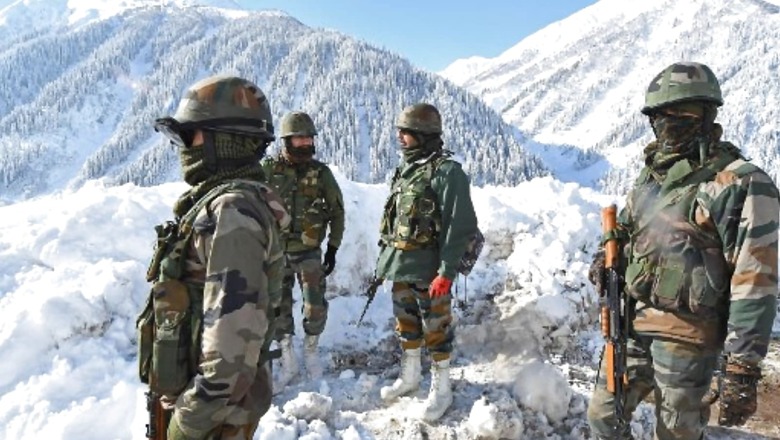
views
Even as India and China continue to remain locked in a military stand-off at the Line of Actual Control (LAC) in eastern Ladakh, China is scaling up its border infrastructure and has also redeployed forces in the depth areas, News18 has learnt.
This includes construction of multiple lateral roads running westwards from China’s G219 highway towards the LAC as well as roads running north-south connecting these lateral roads to each other along the LAC. The G219 highway runs along the western and southern borders of China between Xinjiang and the Tibet Autonomous Region through the disputed Aksai Chin.
Top government sources confirmed that India has been worried about this rapid infrastructure development in the region, particularly with tensions between the two countries lingering at the LAC despite multiple rounds of military and diplomatic talks held between the two countries in the last one-and-a-half years.
New Delhi has communicated to Beijing its concerns over the Chinese infrastructure development as well as a troop buildup in the region during the latest Working Mechanism for Consultation & Coordination of India-China Border Affairs meeting held earlier this month, the sources added.
In the meeting, both sides had agreed on the need to find an early resolution on the remaining issues at the LAC, and to continue ensuring stability on the ground and prevent any untoward incident.
Both countries are yet to decide on the date for the next round of military commanders’ talks.
China’s rapid infra development
According to government sources, China has built at least eight key roads towards the LAC from the G219 highway, including roads from Kangxiwar in China’s southwestern Xinjiang region to the Karakoram Pass in the north, and other routes from the salt water lake Tianshuihai in the Xinjiang region towards Galwan valley and its north.
China has also constructed roads connecting Sirijap at Finger 8 at the north bank of the Pangong Tso lake to the G219. In addition, a highway from China’s Rutog County in the Tibet Autonomous Region to the Spanggur lake south of Pangong Tso has also been built. Further south along the LAC, China has constructed roads from South of Shiquanhe running towards Chumar in eastern Ladakh.
Tianshuihai, Rutog county and Shiquanhe lie close to the G219 highway.
“These additional road constructions and upgradation of existing roads will ensure that China will have a direct road connectivity to areas opposite important Indian military posts along the LAC, from Daulat Beg Oldie (DBO) in the north to Galwan Valley, Pangong Tso and Chumar in the south,” a government source said.
These lateral routes have also been linked at different places by roads running north to south along the LAC. According to sources, most of these roads have been blacktopped and widened.
The sources said China’s military infrastructure also include new deployment areas along these roads for rapid movement of troops towards the LAC. The laterals, they said, can be used to switch forces at places where they would need to be deployed in a faster time frame.
China has also been constructing habitat for its troops and upgrading its airstrips, particularly in the Xinjiang and the Tibet regions.
An ANI report had earlier quoted government sources stating that India is keeping a close watch on the Hotan, Gar Gunsa, Kashghar, Hopping, Dkonka Dzong, Linzhi and Pangat airbases of China’s People’s Liberation Army Air Force (PLAAF), many of which have been reportedly upgraded with the construction of shelters, the extension of runways and additional manpower deployment.
Sources told News18 that China has been constructing heliports at Xaidulla and Tianshuihai in the Xinjiang region as well as in Shiquanhe and Domar in the Tibet region.
In October, Air Chief Marshal VR Chaudhary had said PLAAF is still deployed at three air bases that face eastern Ladakh and is developing infrastructure at a rapid pace.
While no bridges have been constructed over the Pangong Tso by China, small crossings have been created at certain points for the troops to cross the lake during winter, when the lake freezes. China has also built a new jetty at Finger 8 in the north bank of Pangong Tso and has deployed about 50 patrol boats at the lake.
Close to four divisions of PLA troops continue to remain deployed in eastern Ladakh.
India Ramping Up Border Infra at Ladakh
India has also been ramping up infrastructure close to the LAC since last year, including construction of roads and bridges, helipads and habitat for additional troops pumped into the region.
In October, the defence ministry announced the launch of five major road projects in Ladakh to be carried out by the Border Roads Organisation (BRO), including the Hanuthang-Handanbroke-Zungpal-Turtuk road to provide inter-valley connectivity between the Indus Valley and the Shyok Valley. The road will reduce travel time to 3.5 hours from the current 9 hours.
BRO will be building a road connecting Pooh in Himachal Pradesh to Chumar in Ladakh and is also close to completing construction of an alternate road DBO, which will run from Sasoma and connect Saser La and Gapshan before joining the existing route to DBO.
Aside from Ladakh, the BRO is also building multiple roads and bridges in Sikkim and Arunachal Pradesh close to the LAC. In June this year, defence minister Rajnath Singh had inaugurated a 20-km-long double lane Kimin-Potin road, along with nine other roads, in Arunachal Pradesh, and one each in the Union Territories of Ladakh and Jammu & Kashmir.
In June, Rajnath Singh had also inaugurated the Kyungam bridge on the Indus river on the Leh-Loma axis for improved connectivity and faster deployment of troops along the LAC. As many as 11 bridges were inaugurated in Ladakh at the time.
Earlier this month, Indian Army’s Parachute brigade carried out airborne exercise close to the LAC in eastern Ladakh, which included an airborne insertion drill to validate its rapid response capabilities.
Defence sources told News18 that India continues to hold the LAC at eastern Ladakh in strength, with nearly three divisions or around 50,000 troops deployed in the region, including elements of a mountain strike corps.
Read all the Latest India News here


















Comments
0 comment